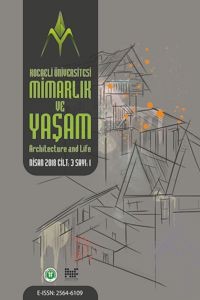Abstract
The correlation between
ornament and architecture has been a symbiotic relationship which continued for
centuries. Although after the changes started with the Modern Movement, the
link between ornamentation and architecture had a disruption which occurred
until recently with the postmodern architectural discourse. The idea and the roots of modern movement has been highly
influenced by universality, functionality and rationality which was born at the
industrial revolution. Furthermore, the aim of modern movement
was to establish a set of universal principles guided by rational and
scientific thinking, therefore the modernist approach stood against the context
that referred to the past and tradition. With this reason, Modern
Movement has often been accused of failing to re-define the culturally
inherited patterns under the unchangeable principles of rational thinking.
However, as the built environment started to become standardized and
homogeneous due to the rational and scientific principles applied in
architecture the idea of universalism could not be adopted as the ideal principle especially in
the societies with a strong tangible and intangible cultural heritage. People need to connect
themselves with the environment that they live in to live comfortably, and at
the same time to have the sense of belonging by the impact of the cultural
memories they have. Therefore, in reality, ornament might not be as much of a
crime as Adolf Loos equated.
Keywords
References
- Alberti, Leon Battista, Architectural Theory from The Renaissance to The Present. Taschen Press, Germany, 2006, p.25
- Benevolo, Leonardo, History of Modern Architecture, Routledge Press, Vol.1, p.3, London, UK, 1971
- Bony, Anne, L'architecture Moderne, Larousse Press, France, 2010, p.84
- Connerton, Paul, How Modernity Forgets, Cambridge University Press, UK, 2009, p.40
- Conrads, Ulrich, Programs and Manifestoes on 20th Century Architecture, MIT Press, USA, 1971, p.19
- Loos, Adolf, Ornament and Crime, Vienna,1908
- Dickens, Charles, A Tale of Two Cities-1891, Penguin Publishing, UK, 2003, p.3
- Erkmen, Elvan, Clemens Holzmeister ve Turk Mimarligindaki Yeri, Doktora Tezi, Istanbul, 1998, p.4
- Glăveanu, Vlad, The Function of Ornaments: A Cultural Psychological Exploration, Journal of Culture and Psychology, Vol.20, USA, 2014, p.87
- Jencks, Charles, The Story of Post-Modernism: Five Decades of The Ironic, Iconic and Critical in Architecture. John Wiley & Sons Publishers, UK, 2011, p.15
- Jirmounsky, Malkiel, Les tendances de l’architecture contemporaine, Paris, France, 1930
- Kruft, Hanno Walter, A History of Architectural Theory from Vitruvius to the Present, Princeton Architectural Press, USA, 1994, p.356
- Kuiper, Kathleen, Ornament in Architecture, Encyclopedia Britannica Online, 2007
- Salingaros, Nikos, A Theory of Architecture, Umbau-Verlag Harald Puschel, Solingen, Germany, 2006, p.222
- Trilling, James, Ornament: A Modern Perspective, Washington University Press, USA, 2003, p.21
- Vitruvius, The Ten Books on Architecture, Sevket Vanli Yayinlari, Istanbul, 1993, p.5
Abstract
Süsleme ve mimari
arasında ilişki yüzyıllardan beri süregelen ve karşılıklı yarar sağlayan bir yapıya
sahiptir. Fakat,
son zamanlardaki Postmodern söylemlerin etkin olduğu döneme kadar, Modern
Hareketin de tesiriyle, mimarideki süsleme ve cephe ilişkisi büyük ölçüde kesintiye
uğratmıştır. Modern Hareketin anafikri ve kökleri, endüstri
devrimiyle doğan evrensellik, işlevsellik ve rasyonaliteye dayanmakta, dahası, rasyonel
ve bilimsel düşünceyle yönlendirilen bir dizi evrensel ilke oluşturmayı amaçlamış, geçmişe ve
geleneklere atıfta bulunan mimarinin karşısında durmuştur. Buna bağlı olarak da
Modern Hareket, rasyonel düşüncenin değiştirilemez prensipleri çerçevesinde
kültürel kalıpları yeniden tanımlayamamakla sıklıkla suçlanmıştır. Fakat
mimaride uygulanan rasyonel ve bilimsel ilkeler nedeniyle şehir dokusu
standartlaşıp daha homojen bir hale gelmeye başladıkça, özellikle evrenselcilik
fikri, köklü bir kültürel mirasa sahip toplumlarda ideal bir ilke haline
getirilememiştir. İnsanlar, her zaman için yaşadıkları çevrede kendilerinin
sahip olduğu kültürel hatıraların etkisine ve aidiyet duygusuna ihtiyaç duymaktadır.
Bu nedenle, gerçekte, süsleme Adolf Loos'un söylediği kadar büyük bir suç
olmayabilir.
Keywords
References
- Alberti, Leon Battista, Architectural Theory from The Renaissance to The Present. Taschen Press, Germany, 2006, p.25
- Benevolo, Leonardo, History of Modern Architecture, Routledge Press, Vol.1, p.3, London, UK, 1971
- Bony, Anne, L'architecture Moderne, Larousse Press, France, 2010, p.84
- Connerton, Paul, How Modernity Forgets, Cambridge University Press, UK, 2009, p.40
- Conrads, Ulrich, Programs and Manifestoes on 20th Century Architecture, MIT Press, USA, 1971, p.19
- Loos, Adolf, Ornament and Crime, Vienna,1908
- Dickens, Charles, A Tale of Two Cities-1891, Penguin Publishing, UK, 2003, p.3
- Erkmen, Elvan, Clemens Holzmeister ve Turk Mimarligindaki Yeri, Doktora Tezi, Istanbul, 1998, p.4
- Glăveanu, Vlad, The Function of Ornaments: A Cultural Psychological Exploration, Journal of Culture and Psychology, Vol.20, USA, 2014, p.87
- Jencks, Charles, The Story of Post-Modernism: Five Decades of The Ironic, Iconic and Critical in Architecture. John Wiley & Sons Publishers, UK, 2011, p.15
- Jirmounsky, Malkiel, Les tendances de l’architecture contemporaine, Paris, France, 1930
- Kruft, Hanno Walter, A History of Architectural Theory from Vitruvius to the Present, Princeton Architectural Press, USA, 1994, p.356
- Kuiper, Kathleen, Ornament in Architecture, Encyclopedia Britannica Online, 2007
- Salingaros, Nikos, A Theory of Architecture, Umbau-Verlag Harald Puschel, Solingen, Germany, 2006, p.222
- Trilling, James, Ornament: A Modern Perspective, Washington University Press, USA, 2003, p.21
- Vitruvius, The Ten Books on Architecture, Sevket Vanli Yayinlari, Istanbul, 1993, p.5
Details
| Primary Language | Turkish |
|---|---|
| Subjects | Architecture |
| Journal Section | Makaleler |
| Authors | |
| Publication Date | April 7, 2018 |
| Published in Issue | Year 2018 Volume: 3 Issue: 1 |

